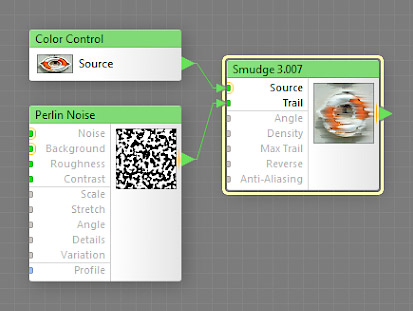
This component is obsolete and its use in filters is not recommended. Use the recent version of the component.
The Smudge component creates a smudge-like effect with adjustable length and density by placing multiple copies ('layers') of the source image on top (or underneath) each other, with decreasing transparency.
This component has two modes: the orthogonal mode which limits the smudge angle to four predefined values, and the normal mode that allows you to adjust the smudge angle freely but makes the component non-seamless. In the normal mode the global Seamless Tiling checkbox becomes disabled, unless you force-enable it in the Overrides dialog or connect Smudge to so-called “seamlessizer inputs”. For more information, see Non-Seamless Components.
This is a map component, it can be located in the Processing category on the Components Bar. Smudge is a bitmap-based component – in order to produce the output image, it renders a bitmap version of the source image. Using bitmap-based components in a filter can increase its rendering time, and, in some cases, degrade the quality of the final image, so Smudge should be used only when necessary. This component can output HDR colors.
Orthogonal
Switches between the orthogonal and normal (non-orthogonal) modes of the component. When turned on, the value of the Angle parameter is limited to four predefined values only. When turned off, the value of the Angle parameter is freely adjustable but the component becomes non-seamless.
Provides the source image. This is a required input – to make Smudge work, this input must be connected.
Trail: Map Input
Adjusts the trail length (which is also affected by the maximum trail length specified by the Max Trail parameter). The value of 0 results in no trail and the value of 100 results in the maximum trail length allowed by the value of the Max Trail parameter. Since Trail is a map input, its value can be controlled separately for different image areas by connecting a map component to this input.
Defines the rotation angle of the layers composing the smudge. When Orthogonal is turned on, available values are 0°, 90°, 180°, and 270°. When Orthogonal is turned off, the value can be freely selected from the range of 0-360.
Defines the opacity fading of the layers composing the smudge. Lower values produce a shorter and softer trail which fades off quicker; higher values generally produce a longer and more solid trail.
Speficies the maximum trail length, that is, the length of the trail when the Trail parameter is set to 100. Max Trail is measured as a percentage of the global Size value. For example, if Size is set to 600 pixels, and Max Trail is set to 10, the resulting maximum trail length will be 60 pixels.
Defines the order of the layers composing the smudge. When turned on, the layers composing the smudge are put 'under' the original image, and each subsequent layer is placed below the previous one. When turned off, the layers are put 'above' the original image, and subsequent layers are placed on top of previously placed ones.
When turned on, makes Trail calculate four pixels and average them to produce the output pixel.
When turned on, the component creates a bitmap cache for the Source input, which may improve the component performance in cases when a subtree connected to the Source input is slow. Due to the fact that a bitmap cache is inherently less precise than the original procedurally-defined source, caching may produce undesirable artifacts.
When turned on, the component creates a bitmap cache for the Radius input, which may improve the component performance in cases when a subtree connected to Radius is slow. Due to the fact that a bitmap cache is inherently less precise than the original procedurally-defined source, caching may produce undesirable artifacts. Has no effect when the Radius input is not connected.